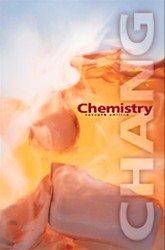 |
1 |  | 
A chemical reaction is at equilibrium when |
|  | A) | the concentrations of reactants is equal to the concentrations of products |
|  | B) | the limiting reagent has been completely depleted |
|  | C) | the rate of the forward reaction equals the rate of the reverse reaction |
|  | D) | A and B. |
 |
 |
2 |  | 
What is the correct equilibrium constant expression for the following reaction? 2 NO2(g) ----> 2 NO(g) + O2(g) |
|  | A) | Keq = [O2]2[NO]/[NO2]2 |
|  | B) | Keq = [O2][NO]2/[NO2]2 |
|  | C) | Keq = [NO2]2/[NO]2 [O2] |
|  | D) | Keq = [NO2]2/[NO][O2]2 |
|  | E) | None of the above |
 |
 |
3 |  | 
The equilibrium constant for the reaction 2 NH3(g) ----> N2(g) + 3 H2(g) is 3 x 10-3 at some temperature. What is Keq for the reaction 0.5 N2(g) + 1.5 H2(g) ----> NH3(g) at the same temperature? |
|  | A) | 0.003 |
|  | B) | 0.05 |
|  | C) | 18 |
|  | D) | 20 |
 |
 |
4 |  | 
Consider the reaction that describes the Haber process for the production of ammonia (NH3): N2(g) + 3 H2(g) ----> 2 NH3(g) for which Kc at 300 oC is 9.5. Calculate Kp for this reaction at 300 oC. |
|  | A) | Kp = 4.3 x 10-3 |
|  | B) | Kp = 9.5 |
|  | C) | Kp = 2.1 x 104 |
|  | D) | Kp = 1.6 x 10-2 |
 |
 |
5 |  | 
For the reaction H2(g) + I2(g) ----> 2 HI(g), Kc = 12.3 at some temperature T. If [H2] = [I2] = [HI] = 3.21 x 10-3 M at that temperature, which one of the following statements is true? |
|  | A) | The concentration of HI will rise as the system approaches equilibrium |
|  | B) | The system is at equilibrium, so the concentrations will not change |
|  | C) | The concentrations of H2 and I2 will increase as the system approaches equilibrium |
|  | D) | The concentrations of H2 and HI will decrease as the system approaches equilibrium |
|  | E) | Not enough information is given to answer the question |
 |
 |
6 |  | 
Kc for the reaction 2 NH3(g) ----> N2(g) + 3 H2(g) is 3 x 10-3 at some temperature. A mixture containing 1.0 mol of NH3, 0.50 mol of N2, and 0.15 mol of H2 is prepared at this temperature When equilibrium is reached, |
|  | A) | there will be more N2 and H2 present |
|  | B) | there will be more NH3 present |
|  | C) | there will be less N2 but more H2 present. |
|  | D) | there will be less NH3 and less N2 present |
|  | E) | No shift will occur |
 |
 |
7 |  | 
If the equilibrium constant for the reaction PCl5 ----> 0.25 PCl3 + Cl2 is 1.0, how many moles of PCl5 must be placed into one liter of solution in order to obtain 0.5 mol of PCl3 when the system reaches equilibrium? |
|  | A) | 0.25 |
|  | B) | 0.50 |
|  | C) | 0.75 |
|  | D) | 1.00 |
 |
 |
8 |  | 
When the reaction CH3Cl + OH- ----> CH3OH + Cl- is started with 0.1 mol of CH3Cl and 0.2 mol of OH-, 0.03 mol of CH3OH is present when the system reaches equilibrium. Calculate the equilibrium constant for the reaction. |
|  | A) | 0.18 |
|  | B) | 0.076 |
|  | C) | 0.0009 |
|  | D) | 0.30 |
 |
 |
9 |  | 
At some temperature, Kc for the reaction PCl5(g) ----> PCl3(g) + Cl2(g) is 0.020. If 0.10 mol of PCl5 and 0.20 mol of PCl3 are added to a 1-L flask, what will be the Cl2 concentration when equilibrium is reached? |
|  | A) | 0.020 mol |
|  | B) | 0.029 mol |
|  | C) | 0.052 mol |
|  | D) | 0.12 mol |
 |
 |
10 |  | 
Consider the following reaction: H2(g) + I2(g) ----> 2 HI(g) for which, at some temperature, Kc = 4.0. When the reaction is started with equimolar quantities of H2 and I2 and equilibrium is reached, 0.20 mol of HI is present. How much H2 was used to start the reaction? |
|  | A) | 0.10 mol |
|  | B) | 0.23 mol |
|  | C) | 0.20 mol |
|  | D) | 4.0 mol |
 |



 2002 McGraw-Hill Higher Education
2002 McGraw-Hill Higher Education

 2002 McGraw-Hill Higher Education
2002 McGraw-Hill Higher Education